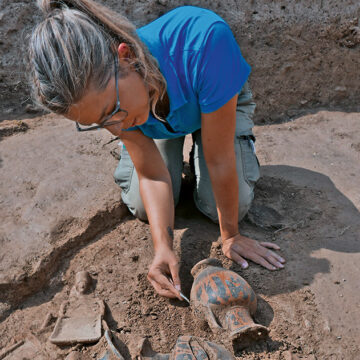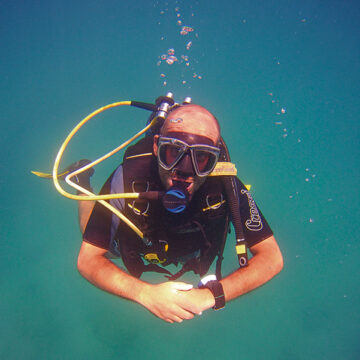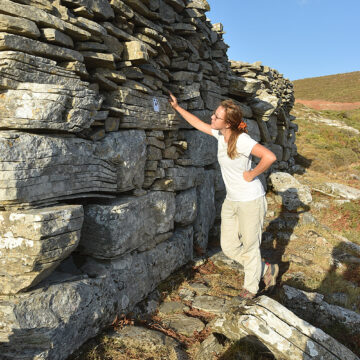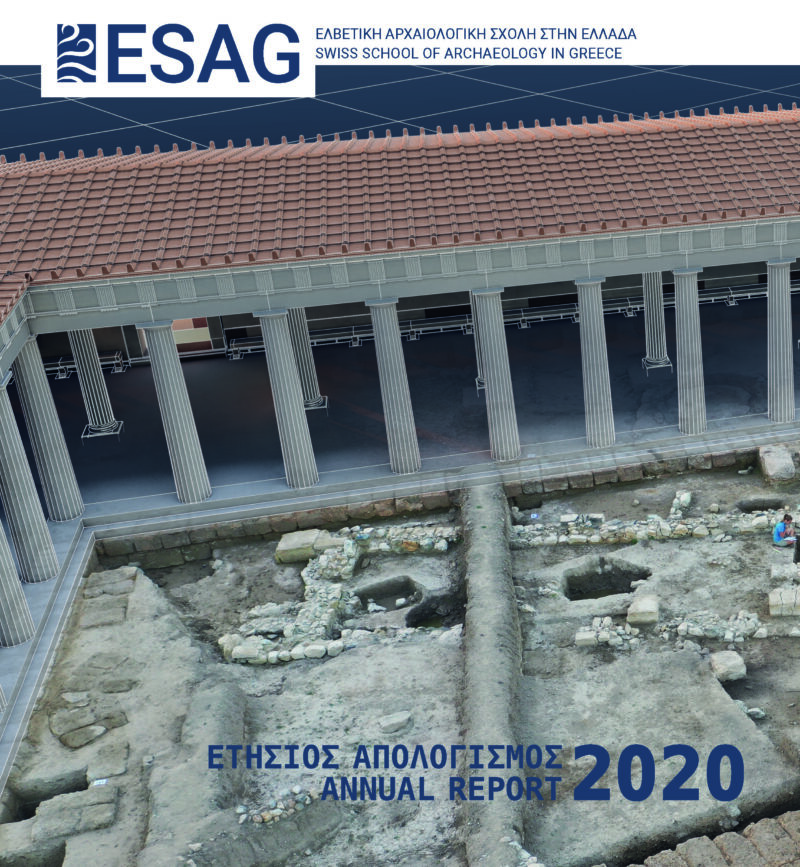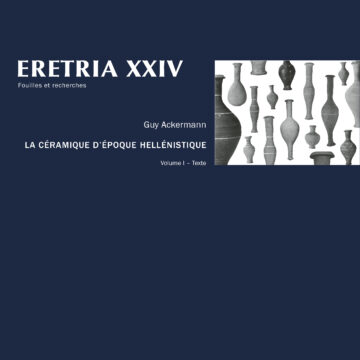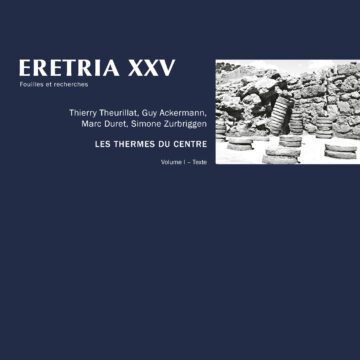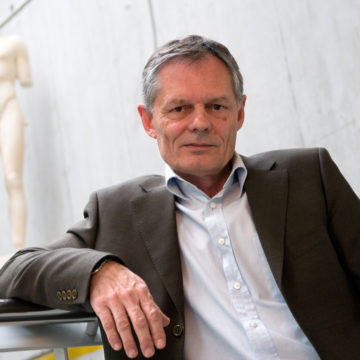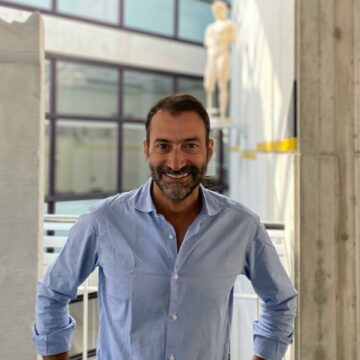Annual Report 2020
Fieldwork
In many ways, 2020 has been a year of contrasts. On the one hand, the Covid-19 pandemic, which considerably restricted our activities, forced us to cancel most public events, including the annual conference in Athens on March 12, the celebration of the Swiss National Day in Eretria on August 1, as well as guided tours of theAmarynthos excavations. On the other hand, exceptional discoveries were made this summer in the Artemision of Amarynthos, despite the strict sanitary conditions and an excavation team reduced to the essentials.
Indeed, the long-sought-after temple of Artemis was conclusively identified during the campaign directed by Tobias Krapf and Thierry Theurillat (20.7–28.8). The excavation of the temple also brought to light an earlier building phase, associated with a rich deposit of offerings from the end of the Archaic period, including vases, metal objects, scarab seals and several other small finds. The northern limit of the sacred space has also become more precise thanks to the discovery of three small oikos-shaped buildings between the north and east stoas.
In addition to the excavations at Amarynthos, the School supported the research project in the Bay of Kiladha (Peloponnese), directed by Andreas Sotiriou (Ephorate of Underwater Antiquities) and Julien Beck (University of Geneva), which took place this summer in a reduced format.
Karl Reber’s interest in the enigmatic “dragon houses” found in the southern part of the island gave rise to the project of surveying and excavating a drakospito at Ilkizes to assess its date and function. Due to sanitary restrictions, only the first part of the investigation was completed this summer: the building was cleaned and thoroughly documented by photogrammetry by Chloé Chezeaux and Jérôme André (University of Lausanne) assisted by Tobias Krapf (ESAG).
New releases in the ERETRIA series
The Eretria series has been enriched with two new volumes this year:
Director's acknowledgments
First and foremost, I would like to thank all ESAG staff members on this very peculiar year for their dedicated commitment in the field and in the museum’s storerooms. Despite the difficult conditions, their contribution was decisive to the success of our activities. Special thanks must go to our two scientific secretaries, Thierry Theurillat and Tobias Krapf, to our head administrator in Athens, Valentina Di Napoli, the intendant in Eretria, Kostas Evangeliou, as well as the restoration team, Harry Giannoulopoulos and Galatia Konsoulidi.
We wish to gratefully acknowledge the continued support and stimulating spirit of collaboration of the Greek archaeological authorities, first and foremost the Directorate of Antiquities in the Greek Ministry of Culture and Sport under the direction of Polyxeni Adam-Veleni, as well as Konstantina Benissi and Sophia Spyropoulou from the Department of Foreign Schools, the Ephorate of Antiquities of Euboea under the direction of Angeliki Simosi, as well as the Ephorate of Underwater Antiquities under the direction of Paraskevi Kalamara. We also extend our gratitude to the collaborators of both Ephorates, in particular Kostas Boukaras, Olga Kyriazi, Fani Stavroulaki, and Stavroula Parissi, as well as to our partners in the ongoing projects at Amarynthos, Amalia Karapaschalidou, and Ilkizes, Maria Chidiroglou.
Special thanks go to the Swiss Embassy in Athens and the Greek Embassy in Switzerland, as well as their respective Ambassadors, Olaf Kjelsen and Ekaterini Xagorari, for their keen interest in our activities. We would also like to thank the municipality of Eretria and its mayor, Ioannis Dimitropoulos, the cultural association of Amarynthos under the leadership of Antonios Karavas and the local association Gerani and its president, Kostas Frangoulopoulos, for their active support.
Finally, the Swiss School of Archaeology in Greece extends its warmest thanks to the active members of its Board of Trustees and Advisory Council. We owe to the tireless efforts of the acting president of the Board of Trustees and former member of the Swiss Federal Council, Pascal Couchepin, and of the vice-president, Pierre Ducrey, the financial support of generous sponsors and institutions: the Swiss National Science Foundation (SNSF), the Federal Department of Economic Affairs, Education and Research, the State Secretariat for Education, Research and Innovation (SERI), the University of Lausanne and the other Swiss universities, the Sandoz Family Philanthropy Foundation, the Stavros Niarchos Foundation, the Théodore Lagonico Foundation, the Afenduli Foundation, the Isaac Dreyfus-Bernheim Foundation, The Société Académique Vaudoise, as well as numerous private donors.
Succession
After fifteen years of teaching and research at the University of Lausanne, I have reached retirement age. Sylvian Fachard (Full Professor) and Othmar Jaeggi (Associate Professor) have taken over the teaching of Classical archaeology at the University of Lausanne on August 1st, 2020. I will, however, continue in my role as Director until the end of the four-year SNSF-funded project on the Artemision at Amarynthos, which will come to an end on June 30, 2021. As of July 1, 2021, Sylvian Fachard will take over the direction of ESAG.
After graduating at the University of Lausanne, Sylvian Fachard was the Scientific Secretary of ESAG from 2002 to 2011. In 2009, he submitted his doctoral thesis at the University of Lausanne, entitled “La défense du territoire. Étude de la Chôra érétrienne et de ses fortifications,” and published in 2012 in the Eretria collection, Fouilles et recherches XXI. After a stay at the Harvard Center for Hellenic Studies in Washington, S. Fachard taught at the Joukowsky Institute for Archaeology & the Ancient World at Brown University. From 2013 to 2016, he continued his research on the borders of Attica at the University of Geneva as part of an SNSF Ambizione grant, before being appointed Andrew W. Mellon Professor at the American School of Classical Studies in Athens. His already prolific career and extensive experience combined with first-hand knowledge of ESAG activities, make him an ideal successor at the head of ESAG. I wish him good luck and every success in his new mandate.
